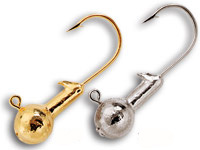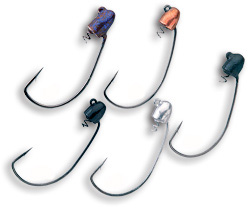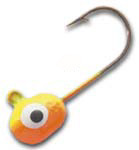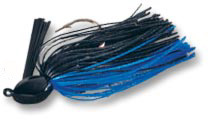
Peek into any angler's tackle box and odds are it'll hold a few fishing jigs. At first glance a jig can appear rather simple in design: a weighted hook matched with a body to add profile. Yet there's more to jig heads and jig baits than one might initially appreciate. This guide will overview the anatomy of jigs and discusses some popular jig bodies.
1. The Anatomy of Jig Baits

basic jig used on the water.
Jigs, except floating jigs, are weighted. The most common range of jig weights for freshwater angling include: 1/64, 1/32, 1/16, 1/8, 1/4, 3/8, 1/2, and 3/4 ounces. Jigs are made using a mold, which shapes metal to form the jig's head and collar. Most jig heads are made from lead, which gives the lure its weight. Tungsten is also becoming a popular substance for weighting jigs as it is heavier than lead and more environmentally friendly.
The metal is heated until a liquid and poured into a mold lined with hooks. The metal then solidifies to create a weighted hook, or jig head. Yet, jig hooks, heads, collars and colors vary; below is a more detailed discussion.
2. About Jig Hooks
Premium jigs contain ultra-sharp hooks while low-cost jigs tend to have regular hooks. O'Shaughnessy hooks or Aberdeen hooks are two common jig styles. A jig hook like Eagle Claw shank is bent before the hook eye anywhere from 90 to 60 degrees on average. The bend in the hook will effect the placement of the eye on the jig head and how the bait moves through the water.
Hook wire diameter has varying applications. Light wire hooks are often used for fishing timber as they will bend and pull free without snagging. These hooks are also used for fishing soft-mouth fish, like crappie. Strong wire hooks perform well in rocky or weedy areas for toothy game fish, like walleye.
Hook shank length should match the size of the body used. Short shanks are favorites for using live minnows, while longer shanks are favored for rigging soft-plastic tubes, worm or lizard bodies. Hook color includes bronze, black, gold, and red; the latter a recent hit as an attractant.
3. About Jig Head Designs
Round heads. Round jigheads are one of the most popular jig styles. The symmetrical head allows it to cut through the water quickly, sinking fast with minimal action on the fall. The hook shank sits flat and the eye points directly upwards.
Tube heads. Tube jigheads come in straight or tapered cylindrical shapes that fit inside a tube jig's hollow body. The hook shank is longer than average to properly position the hook point close to the bait's tail end.
Bullet Head. Bullet head jigheads' streamlined profiles let them cut through the water quickly.
Stand-up heads. Stand-up jigheads feature a flat-bottom design that lies on the bottom when stationary, positioning the hook at a 45 degree angle. The jig's flat head also causes water resistance, slowing the bait's fall.

let them cut through the water quickly
Football heads. Football jigheads resemble a football shape, with the hook eye in the center and the end points to the left and right sides. The jig's wide and curved head prevents it from tipping over on bottom, and the rounded design allows it to climb over rocks when slowly retrieved.
Darter heads. Darter jigheads are cone or bullet-shaped. The jig's streamline profile lets it easily cut through water, making it good for fishing currents. These jigs can be bounced off bottom or brought in on a straight retrieve.
Shaky Heads. Shaky head jigheads are an ever-increasing category of jigs. Most feature a wire, spring or another style of keeper to hold finesse soft-baits, such as worms. Jig head shape is designed to keep the hook and bait up on bottom.
Aspirin heads. These feature flattened sides on the jig head and resemble the profile of a pill. These flat sides allow the jig to quickly cut through water, making it a favorite for bottom jigging in fast current.
Glider or slider heads. These jigheads are finesse jigs. Their flat, lightweight heads cause the jigs to fall very slowly. Hooks are often an offset hook shank so baits can be Texas-rigged.
Mushroom or worm nose heads. These jigheads are like round heads but have a flat back before a barbed or wire collar. This design holds soft-plastic worms or grubs flush against the head for a natural look.
Prop heads have a small propeller at the end of the jig collar. When the jig is retrieved the blade spins emitting flash and vibrations.
Horse and pony heads are specifically designed to hold swivels and spinner blades, with willow and Colorado the more popular. Blades are positioned opposite the hook eye. Banana and boxing glove heads are forward weighted with a rounded bottom. These features allow the bait to be worked over rocks and stumps, making it somewhat snag resistant. When stationary it has a stand-up profile.
Swim and wobble heads are somewhat flat in design with a large surface area that causes them to wobble as they sink towards the bottom.
Airplane heads are similar and feature "wings" on the side to catch water as the jig sinks, resulting in a spiraling downfall.
Shad heads. Shad head jigheads are designed to be rigged with shad bodies, and feature barbed collars to hold the plastic baits. The triangular design of these heads makes them cut through the water easily and can be effective for swimming the bait on a straight retrieve.
Floating heads do just as the name says. These baits are an anomaly from the weighted group discussed above, but belong in a discussion on jig heads. The heads are made from floating material. Jigs are usually tipped with live bait and when fished on a leader above weights can be a deadly presentation.
4. Collars
Collars come in differing designs and are positioned directly after the jig head. Barbed collars have a small point, sometimes two, for holding plastic baits, stopping them from sliding down the hook. Some advanced collar designs feature screws lock or wire holders to grab plastic bodies. A ball collar has a small nub to hold plastics, but also prevents thread from sliding down the hook when the jig is dressed with hair or feathers. Other jigs may have straight collars while others, like live bait jigs, sometimes don't have any.
5. Getting the Right Color Jig Head

Choosing the right color jig head has as much to do with the fishing conditions as it does with angler confidence. Many anglers use two-tone jigs to increase their odds of presenting the right color to finicky fish. Natural, primary, fluorescent, metallic, and glow colored finishes are all available. Some painted jigs also have a protective clear coat to make the paint chip resistant.
The standard painting process for jig heads is dipping them in liquid or powder and sometimes covers the hook eye with paint. Premium jigs often come with open eyes, but some jig eyes are left painted over. A paint punch is a low-cost and handy tool for removing paint from the eye, using a hook point of another jig only dulls the tip, reducing the hooking effectiveness of the jig.
6. Extra Jig Features
Rattles are often added to jigs. Some jig heads come with an extra eye at the back of the head for attaching snelled stinger hooks to trail behind the main jig hook to hook light biters.
Weed and brush guards are two other important jig features. They prevent the hook from catching weeds or wood, making jigs an excellent tool for probing these types of cover. Weed guards are plastic bristles that can be trimmed while brush guards are usually a few wire strands. Both options are anchored in lead just behind the hook eye. The guard angles upwards towards, and slightly beyond, the hook point.
7. Jig-Bait Body Materials
The second part of a jig-bait is the body. It adds bulk and profile to the hook shank.
Some common types are:
Flipping Jigs, also called bass jigs, are the bread and butter of largemouth bass anglers. Jigs heads usually feature a low profile stand-up or football design in weights up to 1/8. Lightweight jigs are great finesse baits and heavier baits are for quickly penetrating the canopy of weeds.
These jigs often come with weed guards and rattles. The body is usually a silicone or rubber skirt (although bucktail and hair are also sometimes used). The skirt strands quiver on the jig's decent and pulsate when the bait is hopped.
Many anglers add a trailer on the hook to increase the bait's profile. Until recently, pork trailers were standard and coined the phrase, jig and pig. Today some still use pork trailers but scented plastics are quite popular.
Bucktail and marabou jigs are dressed with hair or feathers. The material is tied to the jig's collar to form the body. Bucktail and marabou have a tremendous life-like action in the water and hold scent well.
Depending on their size, bucktails can be used for various species including: stripers, northern pike, and lake trout. The durability of the tied on bucktail makes them a top choice for rip jigging weed walleye.
Marabou jigs are very similar to bucktail jigs in their design with some also featuring a blade for flash. These jigs are particularly deadly on panfish. Larger marabou jigs can be excellent bait when tipped with live bait, and an all black jig can be an excellent leech imitation.

material for jigs as it is heavier than
lead and more environmentally friendly.
Soft-plastic jig bodies are the most diverse category simply because there is so much choice. Let's look at five types: grubs, lizards or creatures, worms, tubes and shads.
One of the most widely used combinations of all time would be a ball head jig and a twister-tail grub. On its own, or tipped with live bait, this presentation will fool almost any freshwater game fish. The curled tail emits vibrations when the jig is hopped up off the bottom, and on a straight retrieve it resembles a baitfish.
A football jig head teamed with a 6- to 8-inch lizard or creature-type bait is an excellent lure to work rock flats in search of bass or pike. These baits can be crawled along the bottom and the bait's various appendages pulsate as it bumps into rocks or moves along the bottom. Add a weed guard and this set-up becomes excellent flipping bait.
Mushroom heads and plastic worms are another popular combination. The small profile often matches the thin diameter of worm baits, resulting in a natural presentation. Hopping these baits when fish are active, or crawling them in a cold front, are two methods to fool bass.
Tube jigs are soft-plastic, hollow baits that hold a weighted jig head inside them. The bodies contain tentacles at the hook-end. On slack line these baits slowly spiral in a tight circle. When stationary the tentacles will wave in the water current and when twitched they will pulsate. The tube's hollow design carries commercial scents well.
Shad jigs combine a shad jig head and shad body. The bait's paddle tail mimics a baitfish, wiggling when retrieved. These jigs can be hopped along the bottom or swam back on a straight retrieve. Recently, shad baits have evolved to models where the jig head is completely surrounded by soft-plastic, making the bait feel more natural in a fish's mouth. Many of these new baits also have holographic colors to imitate the shine of baitfish.
Live bait is a category that should be addressed when discussing jig bodies. Many anglers tip grub tail or hair jigs with live bait, but live bait on its own is a widely used presentation. Some common freshwater jig-tipping bait includes: worms, leeches, minnows, crayfish, shrimp, maggots, hellgrammites, American eels, salamanders, and frogs. Rigging techniques for each of these species could be a separate article unto itself; however, a simple rule of thumb is - when it doubt, hook it through the snout. This rigging technique applies to most live bait, excluding crayfish and shrimp, which are better hooked through the tail to mimic their backwards-swimming motion.
Jigs can appear basic when compared to other more intricate fishing lures. On closer inspection one learns that jig design varies to suit different fishing conditions and presentation methods. If you're new to fishing and haven't started using jigs you're missing out on a tried and true fish producer. If you're a seasoned angler, consider trying a jig presentation you've yet to master. Gain confidence using jigs and when to fish them and you'll catch more fish. It's that simple.
Note: Most jigs are weighted with lead and should be handled with caution. Lead can cause birth defects or other reproductive harm. Do not put your hands in your mouth after tying or touching jigs, and wash your hands after if possible.
- 67218 views

